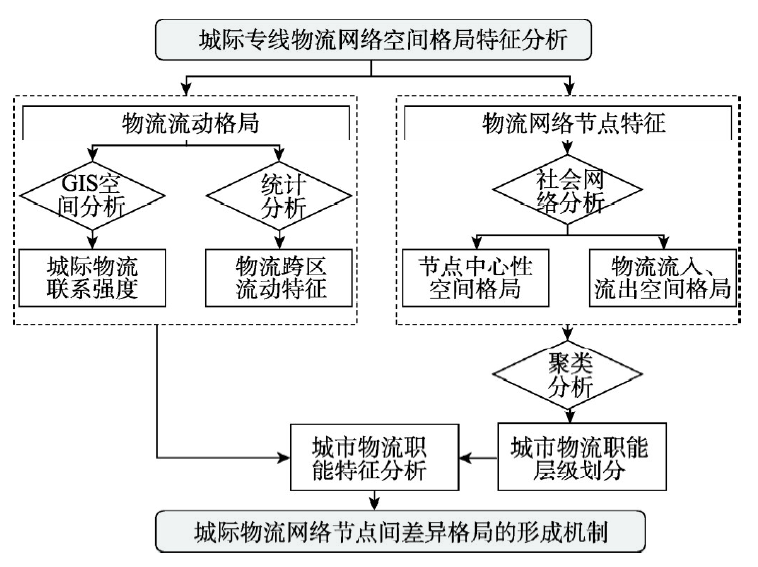

中国城际专线物流网络空间格局
|
任梦瑶(1991-), 女, 河北张家口人, 博士生, 主要从事城市交通与土地利用方面的研究。E-mail: mengyao_ren@hotmail.com |
收稿日期: 2018-08-27
要求修回日期: 2019-12-02
网络出版日期: 2020-06-25
基金资助
国家自然科学基金重大项目(71390335)
国家自然科学基金项目(41801151)
广东省自然科学基金项目(2018A030310691)
版权
Spatial pattern of intercity less-than-truckload logistics networks in China
Received date: 2018-08-27
Request revised date: 2019-12-02
Online published: 2020-06-25
Supported by
Major Program of National Natural Science Foundation of China(71390335)
National Natural Science Foundation of China(41801151)
Natural Science Foundation of Guangdong Province, China(2018A030310691)
Copyright
物流是地域间社会经济联系的重要要素,城市间的物流联系是理解区域生产消费联系和城市空间体系的重要视角。但是由于数据与方法等层面的不足,较少有研究能够有效地揭示全国城市间的物流网络格局。近年来随着互联网与数据科学的发展应用,第四方物流平台的出现及其对各类物流资源和数据的整合为物流研究提供了新的数据源和基础平台。本文采集了中国规模最大的电子商务平台旗下第四方物流平台上的物流专线交易数据,采用社会网络分析方法,以地级市为空间单元汇总计算到发各城市的物流订单,测算各城市的专线物流联系强度以及网络中心性,旨在揭示中国城际专线物流的联系格局,透视各城市在全国专线物流网络中的职能差异。研究发现:① 中国城际专线物流联系强度的空间分布与区域间社会经济发展格局基本一致,以“京津冀—长三角—珠三角”为核心,呈现出由沿海向内陆地区梯度递减的趋势;② 中国城际专线物流具有明显的跨区流动特征,1200 km距离范围内的专线物流活动最为活跃;③ 依照全国专线物流网络中的职能特征,可将各城市划分为全国物流首位城市、全国物流中心城市、全国物流节点城市、区域物流节点城市和地区物流节点城市5类。上述研究结论期望从专线物流联系的视角为国家与各区域及城市制定空间规划及专项规划提供支撑。

任梦瑶 , 肖作鹏 , 王缉宪 . 中国城际专线物流网络空间格局[J]. 地理学报, 2020 , 75(4) : 820 -832 . DOI: 10.11821/dlxb202004011
Freight logistics is one of the most important socioeconomic connection elements between regions. The intercity logistics connection is an important perspective to understand regional production-consumption relationship and urban spatial structure. However, due to the lack of data and methods, few studies can effectively reveal the intercity logistics network pattern at the nation level. With the development and application of Internet and data science, the logistics resources and data integrated by the fourth party logistics platform provide new data source and research foundation for logistics studies. Drawing online less-than-truckload logistics transaction data for 3 months from November 2017 to January 2018, from the largest 4th party logistics (4PL) platform in China, this research aims to explore the intercity logistics connection pattern and urban logistics function differences. The outbound and inbound transaction numbers were calculated first for each prefecture-level city. With the approach of social network analysis (SNA), the logistics connection intensity and corresponding centrality were then computed and visualized for each city in the network. The research results show that: (1) the intercity logistics landscape roughly coincides with interregional socio-economic development. Taking three metropolises (i.e., Beijing-Tianjin-Hebei, Yangtze River Delta, and Pearl River Delta) as core triangle corridors, the national logistics connection pattern decreases from coastal area to inland areas. (2) Logistics activities are characterized by significant cross-regional flow. Active are intercity logistics shipment activities within the threshold of 1200 km distance. (3) According to the less-than-truckload logistics (LTL) network pattern, cities in China could be further divided into five categories, namely the national primary logistics city, national logistics center cities, national logistics node cities, regional logistics center cities and local logistics cities. These conclusions are expected to, from the perspective of intercity logistics connections, support national, provincial and city governments to make spatial planning and logistics planning.

图2 2017年11月—2018年1月中国城际专线物流联系强度空间分布注:基于国家测绘地理信息局标准地图服务网站下载的审图号为GS(2016)1569号的标准地图制作,底图无修改。 Fig. 2 Connectivity intensity profile in national LTL logistics network from November 2017 to January 2018 |
图6 基于物流网络中心性的城市物流层级结构Fig. 6 Urban hierarch and classification based on the centrality of national LTL network |
表1 各层级城市及其物流职能特征Tab. 1 Cities and their functional characteristics at different logistics levels |
| 类别 | 城市 | |
|---|---|---|
| I 全国物流首位城市 | 上海**(1个) | |
| Ⅱ 全国物流中心城市 | Ⅱ-1输出型 | 深圳**、宁波**(港口型物流中心城市2个) |
| 苏州**、东莞*、佛山*(制造型物流中心城市3个) | ||
| 广州**、杭州**(枢纽型物流中心城市2个) | ||
| Ⅱ-2输入型 | 北京**、天津**、成都**、重庆**、武汉**(5个) | |
| Ⅲ 全国物流节点城市 | 沧州、无锡*、绍兴、温州*、泰州、金华*、台州、青岛**、常州、泉州*、南通*、嘉兴、郑州**、汕头、阳江、中山、新乡、厦门**、廊坊、南 京**、西安**(21个) | |
| Ⅳ 区域物流节点城市 | 衡水、惠州、洛阳*、潮州、邢台、湖州、潍坊*、江门、烟台*、揭阳、保定*、镇江、盐城、扬州、济南**、徐州*、石家庄**、福州**、合肥**、沈阳**、长沙**、大连**、昆明**、哈尔滨**、长春**(25个) | |
| V 地区物流节点城市 | 南宁**、贵阳**、唐山*、南昌**、邯郸*、太原**、海口**、兰州**、乌鲁木齐**、呼和浩特**、西宁**、银川**、拉萨**……(186个) | |
注:根据《全国流通节点城市布局规划(2015—2020年)》;**表示该城市被列为国家级流通节点城市;*表示该城市被列为区域级流通节点城市。 |
| [1] |
[ 顾朝林, 庞海峰 . 基于重力模型的中国城市体系空间联系与层域划分. 地理研究, 2008,27(1):1-12.]
|
| [2] |
[ 沈丽珍, 顾朝林 . 区域流动空间整合与全球城市网络构建. 地理科学, 2009,29(6):787-793.]
|
| [3] |
[ 肖作鹏, 王缉宪, 孙永海 . 网络零售对物流供应链的重组效应及其空间影响. 经济地理, 2015,35(12):98-104.]
|
| [4] |
|
| [5] |
|
| [6] |
|
| [7] |
|
| [8] |
|
| [9] |
|
| [10] |
[ 韩增林, 王成金, 尤飞 . 我国物流业发展与布局的特点及对策探讨. 地理科学进展, 2002,21(1):81-89, 96.]
|
| [11] |
[ 王成金, 张梦天 . 中国物流企业的布局特征与形成机制. 地理科学进展, 2014,33(1):134-144.]
|
| [12] |
[ 宗会明, 周素红, 闫小培 . 全球化下地方综合服务型物流企业的空间网络组织: 以腾邦物流为案例. 地理研究, 2015,34(5):944-952.]
|
| [13] |
[ 刘承良 . 中国大陆物流经济联系空间结构实证分析. 经济地理, 2004,24(6):826-829, 868.]
|
| [14] |
[ 谢守红, 蔡海亚, 朱迎莹 . 长三角城市群物流联系与物流网络优化研究. 地理与地理信息科学, 2015,31(4):76-82.]
|
| [15] |
[ 张定, 曹卫东, 范娇娇 , 等. 长三角城市物流发展效率的时空格局演化特征与机制. 经济地理, 2014,34(8):103-110.]
|
| [16] |
[ 梁双波, 曹有挥, 吴威 . 长江三角洲地区物流供应链时空演化及其影响因素: 基于国际货代企业数据的分析. 地理研究, 2017,36(11):2156-2170.]
|
| [17] |
[ 倪玲霖, 王姣娥, 胡浩 . 中国快递企业的空间组织研究: 以顺丰速运为例. 经济地理, 2012,32(2):82-88.]
|
| [18] |
[ 肖作鹏, 邹海翔, 孙永海 . 利用货车GPS数据推演城市内部物流空间联系. 西部人居环境学刊, 2017(1):29-33.]
|
| [19] |
[ 李国旗, 金凤君, 陈娱 , 等. 基于POI的北京物流业区位特征与分异机制. 地理学报, 2017,72(6):1091-1103.]
|
| [20] |
[ 董琦, 甄峰 . 基于物流企业网络的中国城市网络空间结构特征研究. 人文地理, 2013,28(4):71-76.]
|
| [21] |
[ 李国旗, 金凤君, 陈娱 , 等. 基于物流热度的中国物流业空间格局. 地理科学进展, 2015,34(5):629-637.]
|
| [22] |
[ 刘思婧, 李国旗, 金凤君 . 中国物流集群的量化甄别与发育程度评价. 地理学报, 2018,73(8):1540-1555.]
|
| [23] |
[ 刘正兵, 戴特奇, 廖聪 , 等. 中国城际公路货运空间网络特征: 基于“第一物流”网站数据. 经济地理, 2017,37(6):28-35.]
|
| [24] |
[ 许金花, 刘秀田 . 专线运输物流模式研究. 交通企业管理, 2007,22(8):52-53.]
|
| [25] |
[ 刘秀田, 安军玲, 王玖河 . 零担专线运输物流管理信息系统研究. 物流技术, 2010,29(9):124-127.]
|
| [26] |
[ 侯赟慧, 刘洪 . 基于社会网络的城市群结构定量化分析: 以长江三角洲城市群资金往来关系为例. 复杂系统与复杂性科学, 2006,3(2):35-42.]
|
| [27] |
[ 甄峰, 王波, 陈映雪 . 基于网络社会空间的中国城市网络特征: 以新浪微博为例. 地理学报, 2012,67(8):1031-1043.]
|
| [28] |
Ministry of Commerce of the People's Republic of China. The National Logistics Cities Layout Planning (2015-2020), 2015.
[ 中华人民共和国商务部. 全国流通节点城市布局规划(2015—2020). 2015.]
|
| [29] |
[ 孟德友, 李小建, 陆玉麒 , 等. 长江三角洲地区城市经济发展水平空间格局演变. 经济地理, 2014,34(2):50-57.]
|
| [30] |
|
/
| 〈 |
|
〉 |